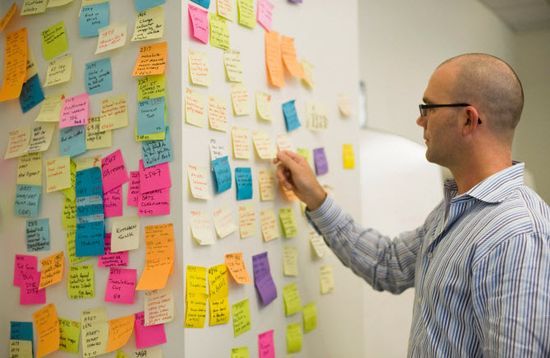
SAP is embedding design thinking into its software innovation and development practice. You can benefit from SAP’s experience in the application of design thinking by taking part in this course, Developing Software Using Design Thinking.
Please note: The registration for group work has ended and the working groups are set up. However, you can still enroll for this course. You can watch the videos and do the assignments, but you cannot participate in the group work and you cannot do the collaborative exercises.
This course was retired in October 2023.
Language: English
Course information

This course was retired in October 2023.
Course Summary
You may have heard the exciting stories about design thinking and wondered what it is and whether it is for you. In this course, you will experience design thinking. To start down the path toward innovative solutions, focus on the problem first: Develop empathy for your users by “putting yourself in their shoes”, and further understand their perspectives by defining a point-of-view statement. From there, you will start generating ideas and then move on to building low-resolution prototypes, which you can take back to your users for feedback. This will prepare you for the deliver phase, where you will learn how design thinking is connected to lean principles and single-piece processing.
Although design thinking can be applied to a wide range of problem contexts, we focus specifically on its application to software development. The course uses easy-to-understand, real-world examples, and allows you to collaborate with fellow students on a real-life challenge. Welcome to the course and we hope you enjoy the journey!
Course Flow per Week

Course Characteristics
- Starting from: September 14, 2015, 09:00 UTC. (What does this mean?)
- Duration: 7 weeks (3-5 hours per week)
- Course language: English
Course Content
- Getting Started: Course Preparation Week
- Week 1: Overview of Design Thinking
- Week 2: Empathy Phase
- Week 3: Define Phase
- Week 4: Ideate Phase
- Week 5: Prototype & Test Phases
- Week 6: Deliver Phase
Target Audience
- Anyone interested in Design Thinking
- Software professionals
- University students
Course Requirements
Willingness to work in a team and collaborate with other course participants
Working in Groups
Design thinking is about teamwork and about collaboration within groups. To enable you to learn about design thinking effectively and apply it in the future, you will be assigned to a group.
In the course preparation week, we will set up the groups in such a way that you are located as close as possible to each other, but there will be participants who will have to work in virtual mode. In this case, we will make sure that you are grouped with other participants in similar time zones.
During the course, you will meet regularly either in person or virtually, and you will collaborate closely with your peers to complete collaborative activities.
About the Instructors
Dr. Moritz Gekeler

Design Strategist, Design and Co-Innovation Center, SAP
As a member of the Design and Co-Innovation Center at SAP Moritz leads strategic design and co-innovation projects with customers from various industries. He facilitates the design process, hosts workshops and conducts deep dive research sessions. Moritz has a strong background in strategic design thinking, design facilitation and teaching. Before joining SAP he worked for the HPI School of Design Thinking and for the futures studies department of Daimler AG. On the side he is regularly engaged as a lecturer at various universities teaching design theory and innovation strategy.
Jochen Guertler
Strategic Design Consultant, Design and Co-Innovation Center, SAP
In his role as strategic design consultant Jochen setups and runs Design Thinking workshops and projects with SAP customers. Besides that he is an business coach and also teacher at the School of Design Thinking at the Hasso Plattner Institute in Potsdam. Jochen is co-author of two books about Design Thinking and loves to use Design Thinking also as motivation for people and teams to grow and learn also on a personal level.
George Kembel

Global Director and Co-Founder, Stanford d.school
George is an entrepreneur and investor turned educator. He co-founded the d.school and now leads its global effort.
Passionate about nurturing the creative potential of others, George spends his time working with students, teachers, leaders, and investors to unlock the latent innovative capacity of their teams and organizations.
http://dschool.stanford.edu/bio/george-kembel/
Course contents
Course content no longer available
Getting Started:
Course Preparation WeekWeek 1:
Overview of Design ThinkingWeek 2:
Empathy PhaseWeek 3:
Define PhaseWeek 4:
Ideate PhaseWeek 5:
Prototype & Test PhasesWeek 6:
Deliver PhaseI Like, I Wish:
We Love Your Feedback … And Want More
Enroll me for this course
Learners
Certificate Requirements
- Gain a Record of Achievement by earning at least 50% of the maximum number of points from all graded assignments.
- Gain a Confirmation of Participation by completing at least 50% of the course material.
Find out more in the certificate guidelines.